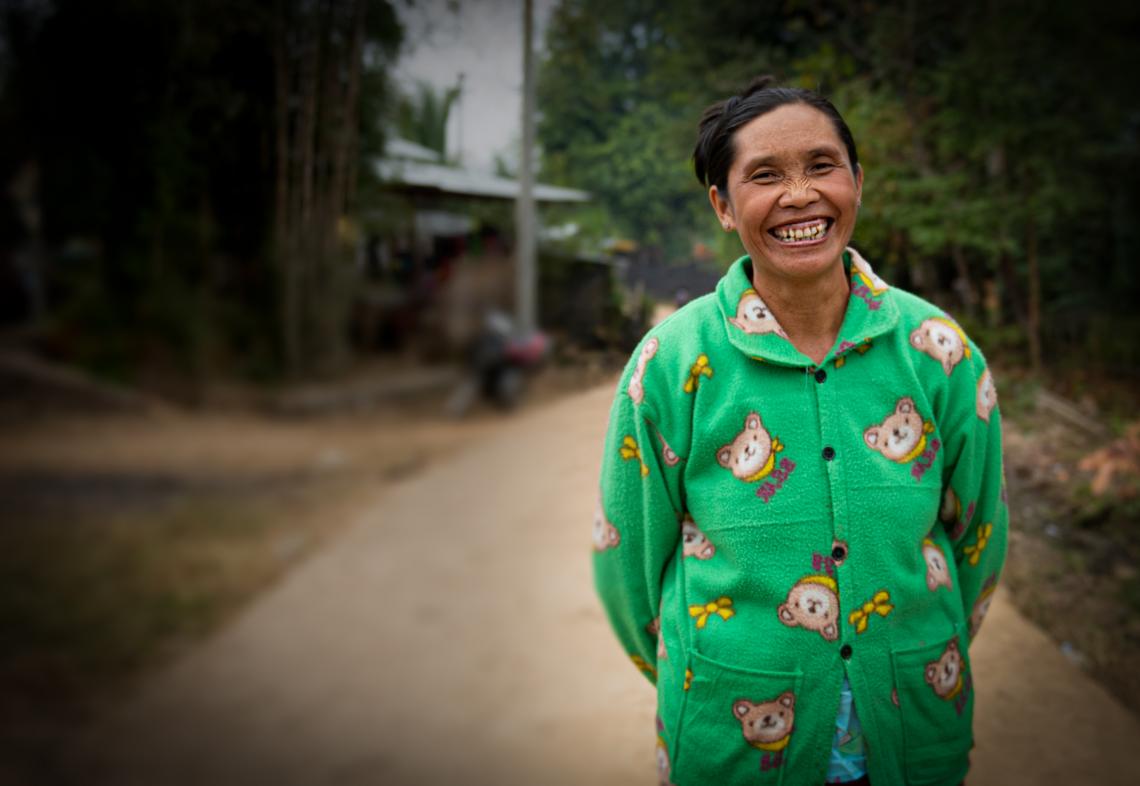Mu Mu Aye is the Secretary of Shwe Inlay and leads a local chapter of the May Doe Kabar network, which represents women in the Intha community. She organises training workshops to help build women’s confidence to participate in village affairs, enhance livelihoods, and empower women to speak out in their communities.
This story is featured in the Asia Research News 2021 magazine. Read in ISSUU (above) or full text and images below.
Gender gaps were starting to shrink. In November 2020, the number of women elected to Myanmar’s national, subnational and regional parliaments increased from about 10 percent to around 17 percent. The military coup in February 2021 prevented many elected representatives from taking their seats. As of press time, the military had pledged to hold new elections after a one-year state of emergency.
“We were happy to see more women elected in 2020 and believe they should be allowed to serve,” says Aye Lei Tun, gender research program manager at the Enlightened Myanmar Research Foundation (EMReF). “We still have a long way to go to achieve gender equality in politics and in Myanmar.”
Over the past several years, Myanmar think tanks have been conducting in-depth research surveys to understand what helps and hinders women’s participation in governance and civic spaces at the local, state and national levels. While carried out before the coup, the findings still apply and provide nuanced insights. These locally led projects were supported by the Knowledge for Democracy Myanmar Initiative (K4DM), a five-year research initiative from Canada’s International Development Research Centre (IDRC) and Global Affairs Canada.
“Research and data about Myanmar generated by Myanmar scholars is important for the country’s transition towards democracy,” says Edgard Rodriguez, the lead program officer for K4DM. “Local researchers are communicating their findings to their communities. These efforts can help boost gender equality and, in turn, prosperity for Myanmar.”
CULTURAL NORMS
While Aung San Suu Kyi, the country’s de facto leader until the coup, is popular among many Myanmar citizens, the same level of respect for women leaders does not trickle down to the local level.
“In villages and townships, women are not viewed as leaders,” says La Ring, an EMReF researcher. “Even though women attend community meetings, decisions are usually made by men.”
Through surveys and interviews, researchers from EMReF and the Gender Equality Network (GEN) found social norms present a major barrier to women entering civic life throughout the country.
Culturally, women are assumed to be caretakers who stay home, raising children, not out leading their communities or working as the primary income earner. This is a perspective typically shared by both men and women: the majority of women respondents said doing household chores is not a drawback for them.
“Many women have internalized that household chores are their responsibility,” says Soe Myat Tun, a researcher at GEN. “This shows we need to educate women and men that chores are not solely the responsibility of women, they are also the responsibility of men, so women have more time to participate in public life.”
FINANCIAL BARRIERS
Women lack financial support for running for office and for childcare, putting them at a disadvantage compared to men. “When you get involved in politics, you have to use a lot of your own money,” says May Sabe Phyu, director of GEN. “Since women are not the primary income earners, they depend on their husbands or male family members for financial support.”
Once elected, representatives are not paid very much, making it difficult for both men and women, but especially single mothers holding down a job and caring for their children. Women who do participate in politics tend to come from political families with more resources, much like Aung San Suu Kyi.
Having so few women in decision-making roles has a lasting effect, additional K4DM-supported research from the Myanmar Institute for Gender Studies (MIGS) found. Without women’s voices in decision making bodies, it is difficult to secure more funding for women’s needs and priorities, such as education, childcare and health services. This in turn continues to inhibit women from having the support they need to get involved.
“This creates a vicious cycle inhibiting women’s opportunities and voices, which is why it is so important to have women in leadership roles and policies that elevate women’s priorities in budgets at local, state and national levels,” says Khin Ma Ma Myo, founder of MIGS.
POLITICAL PARTIES & GENDER EQUALITY
Over the last decade, political parties in Myanmar – of which there are dozens – have played a huge role in deciding who can run as candidates.
“Myanmar citizens tend to vote along party lines, so how parties recruit and promote female candidates is critical to increasing gender equality and representation,” says Netina Tan, a political scientist at McMaster University in Canada who collaborated with EMReF. “Candidate selection committees are heavily male dominated and that influences how candidates are selected.”
In-depth interviews with nine political parties by EMReF researchers found parties nominated and selected candidates in various ways. Those with clear procedures that start nominating delegates at the village level tend to have more women candidates than parties who control the nomination process via a central selection committee and party gatekeepers. The proportion of women candidates for political parties in 2015 ranged between 4 and 19 percent. That increased to between roughly 9 and 29 percent in 2020.
In 2020, both the Chin National League for Democracy (CNLD) and the Shan Nationalities League for Democracy (SNLD) set 30% quotas for women candidates running for seats. While CNLD fell far short of the goal, SNLD nearly reached it. “That was a big step forward and shows how even societies that are traditionally highly patriarchal can work to change gender relations,” says Tan.
CLOSING THE GAP
Based on these findings, the researchers recommend parties expand female participation by taking a number of steps: set clear rules for the nomination process that starts at the local level; establish party quotas for women candidates; provide financial support for women candidates; help women campaign in rural areas by providing an escort to increase security; and provide more training for women interested in running to practice campaign and parliamentary skills.
While there was some resistance to quotas among members of parliament, the general population supports the idea of quotas for female candidates, the researchers found.
Na Bo served as assistant village head of her Lahu village in Shan State. Villagers respected her, especially her ability to help solve disagreements. She says education and role models are critical for helping more young women take leadership roles.
ETHNIC VOICES
As part of the K4DM research initiative, the Myanmar Institute for Integrated Development (MIID) and local partners interviewed several ethnic groups in Shan State to understand how decisions are made at the local level. Their research also showed traditional cultural norms are entrenched.
For example, in the Pa-O Self Administrative Zone, in southern Shan State, customary rules mandate that men are the main decision makers. And in Eastern Shan State, “According to Palaung tradition, women are not allowed to participate. It is impossible,” says Paw Saung, one of four village heads in a Palaung village.
But there are positive signs of change. For example, Ma Mi Shel is a respected leader in her Akha village, even though she is only in her 20s. Her father, a former village leader, encouraged her to be involved in village administration, and has ensured that she will inherit the family farm, despite Akha tradition preventing women from inheriting any family assets.
In a Lahu village, Na Bo became an assistant village head. Originally, her husband was selected for the role, but since he was often away working, she took on the responsibilities, even though she cannot read nor write. “I resolved many problems. The villagers didn’t oppose me being a woman,” Na Bo says. “They said I have a sense of influence and leadership skills when I talk.”
EDUCATION IS CRITICAL
Most of the MIID survey respondents stressed that education for children and adults is key to achieve gender equality. Several community organizers are hosting workshops to educate women about women’s rights, domestic violence, and gender equality. They also aim to increase women’s knowledge about current affairs, so they have confidence to participate in village affairs.
Trainings are having a positive effect. Mu Mu Aye is the Secretary of Shwe Inlay and heads a chapter of a regional women’s network. Before 2010, she said women in her region would only sit and listen during village meetings. After 2010, many organizations began conducting leadership and gender trainings. Now, women actively participate in meetings and serve on village development committees with widespread acceptance.
While, as of press time, it is unclear what will happen in the coming months, this evidence shows how grassroots efforts, combined with larger structural policy and funding changes, can help continue to shrink the gender equality gap throughout Myanmar.
“It’s very clear that through the democratization process, there is more space for women to engage in governance and take leadership roles in their communities,” says GEN’s May Sabe Phyu. “We must continue the hard work driving this change forward, using all of our local research to inform policies that will support girls and women.”
Further information
Edgard Rodriguez
[email protected]
Knowledge for Democracy Myanmar Initiative
International Development Research Centre (IDRC)





